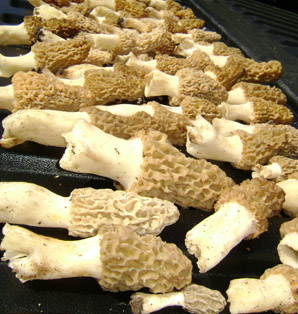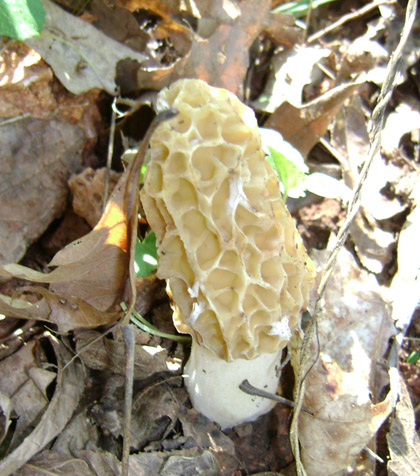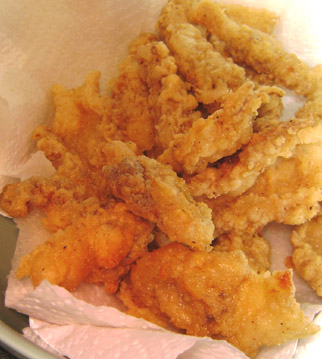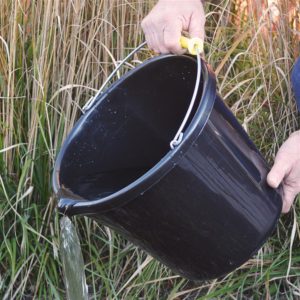
Spring is an amazing time of year. Along with a complete change of landscape, spring brings forth the “lords of the woods†… morel mushrooms. With this year’s cooler spring, morels are still being found, even later than ever before.
The tasty little fungi often show themselves on a warm spring day immediately following a rain. They tend to be found in shady areas, often on north-facing slopes in the northern hemisphere that never receive direct sunlight. But they can be found in other areas where cover provides near-constant shade.
The visible mushroom that rises from the Earth’s soil on a spring day is simply the “fruit†of the species. The real work happens underground near the surface where a web-like “mycelium†can spread through the soil for great distances … sometimes up to several acres. Alone, a mycelium cannot produce mushrooms, but when two mycelium cross paths – that’s when we can benefit greatly from this subterranean union.
Look for morels in shady areas, with ash, elm or sycamore trees, especially if the trees are dead or dying. Another good tip is to look for an area where mayapples are growing. Since morels tend to favor the decaying wood of certain trees, don’t overlook searching areas where large areas of timber have burned in the past, or where sawmills once stood.
Mushroom hunters often use a mesh bag to carry their finds. It’s reasoned that carrying the morels in a bag with tiny holes in it will allow any spores jostled free to drop to the ground where the soil has already proven to be conducive to housing the underground mycelium. When you locate a morel this year, as you pick or slice the stem at ground level give the mushroom a couple gentle taps on the ground. Doing so can help disperse the mushroom’s spores back into the fertile soil to better the odds for future finds.
Veteran mushroom hunters will rarely reveal where to find the tasty treats. Families have been known to keep ‘good grounds’ secret for generations.
 Be Cautious When Mushroom Hunting
Be Cautious When Mushroom Hunting
All mushroom stories should come with a disclaimer, and this one is no different. Warning — If you are a novice morel hunter, be sure to accompany someone who is experienced or at a minimum consult a reliable guide book. Be aware of the false morel, a mushroom that looks similar to a morel but that is incredibly toxic when eaten raw.
Guidebooks will contain photos and drawings showing the difference between true and false morels. There are a long list of ‘shrooms which can be toxic and even fatal if ingested, and unfortunately they often appear similar to their edible relatives.
Harvesting And Cleaning Morels
Cut or pinch the morel at ground level. Place the tender treats in a mesh bag, or an old onion bag. Otherwise, toting them in a paper bag is best. Do not keep them in an enclosed plastic bag for an extended time, which can lead to dangerous mold. If your morels mold, discard them immediately.
Once back at home rinse the find in a bowl of cool salted water. Inevitably the mushrooms will be housing ants, centipedes and other small creatures in the hollow stem and crevices of the hood. The first soak in salted water will get rid of them.
After 20 minutes or so, empty the water and refill the bowl with cool salted water and repeat the process.
Next, cut each mushroom from the peak of the hood to the bottom of the stem one time lengthwise. Note that the stem is completely hollow its entire length. This is yet another indication of a true morel. Now let the pieces soak in a bowl of fresh cool salted water until you prepare them for eating. Never eat a morel raw.

Cook Simply, and Enjoy!
There are many ways to prepare morels. Some cooks prefer to sauté the pieces in butter only. Another simple but tasty preparation is to batter and pan fry.
A simple batter is best. Dip each piece in a mixture of egg and milk stirred together. Now roll the dampened pieces in a dry mix of flour, spices of your choice, or perhaps cracker crumbs. Other coating options can include pre-packaged fish seasoning coatings, cornmeal or mashed potato flakes.
Drop the coated morel pieces into a pan or skillet of hot cooking oil. Turn once so each side becomes a light golden brown. Remove the pieces from the skillet and place in a bowl or plate lined with a towel to absorb the excess cooking oil. Let cool and enjoy.
































